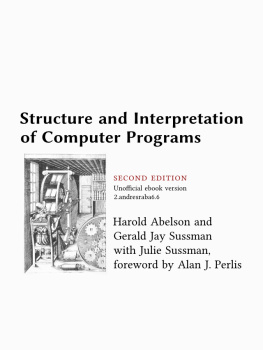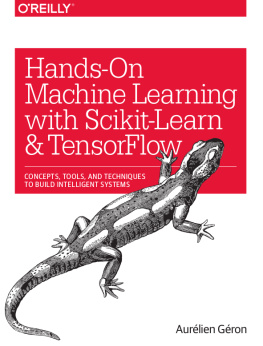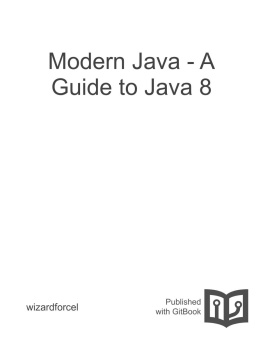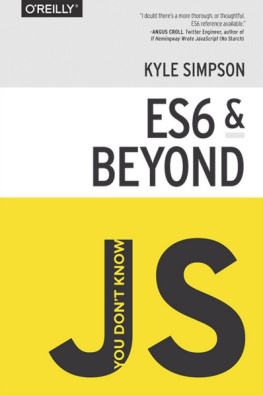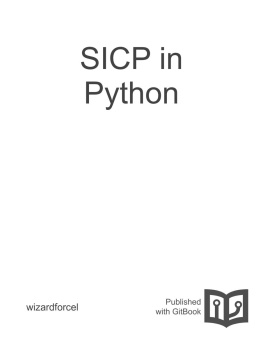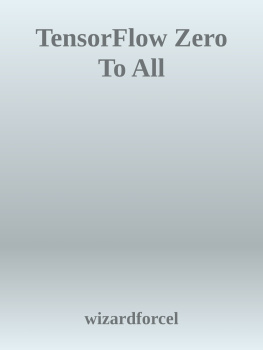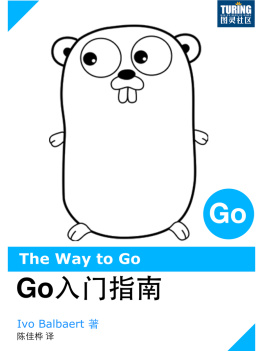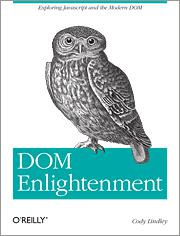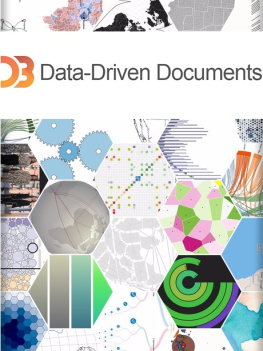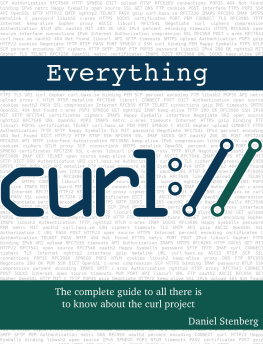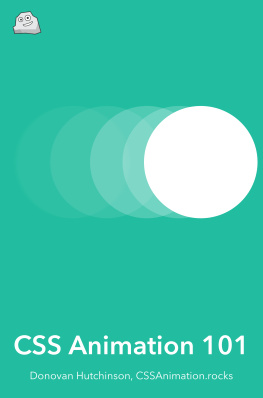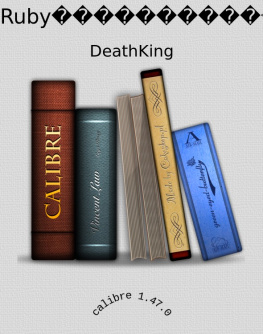it-ebooks - SICP 2e (MIT 6.001)
Here you can read online it-ebooks - SICP 2e (MIT 6.001) full text of the book (entire story) in english for free. Download pdf and epub, get meaning, cover and reviews about this ebook. year: 2017, publisher: iBooker it-ebooks, genre: Home and family. Description of the work, (preface) as well as reviews are available. Best literature library LitArk.com created for fans of good reading and offers a wide selection of genres:
Romance novel
Science fiction
Adventure
Detective
Science
History
Home and family
Prose
Art
Politics
Computer
Non-fiction
Religion
Business
Children
Humor
Choose a favorite category and find really read worthwhile books. Enjoy immersion in the world of imagination, feel the emotions of the characters or learn something new for yourself, make an fascinating discovery.
- Book:SICP 2e (MIT 6.001)
- Author:
- Publisher:iBooker it-ebooks
- Genre:
- Year:2017
- Rating:5 / 5
- Favourites:Add to favourites
- Your mark:
- 100
- 1
- 2
- 3
- 4
- 5
SICP 2e (MIT 6.001): summary, description and annotation
We offer to read an annotation, description, summary or preface (depends on what the author of the book "SICP 2e (MIT 6.001)" wrote himself). If you haven't found the necessary information about the book — write in the comments, we will try to find it.
SICP 2e (MIT 6.001) — read online for free the complete book (whole text) full work
Below is the text of the book, divided by pages. System saving the place of the last page read, allows you to conveniently read the book "SICP 2e (MIT 6.001)" online for free, without having to search again every time where you left off. Put a bookmark, and you can go to the page where you finished reading at any time.
Font size:
Interval:
Bookmark:
of Computer Programs
Unofficial Texinfo Format 2.andresraba6.6
1996 by The Massachusetts Institute of Technology
SVGSVGSVGThis work is licensed under a Creative Commons Attribution-ShareAlike 4.0International License (CC BY-SA 4.0).Based on a work at mitpress.mit.edu.
The MIT Press
Cambridge, Massachusetts
London, England
McGraw-Hill Book Company
New York, St. Louis, San Francisco,
Montreal, Toronto
This book is one of a series of texts written by faculty of the ElectricalEngineering and Computer Science Department at the Massachusetts Institute ofTechnology. It was edited and produced by The MIT Press under ajoint production-distribution arrangement with the McGraw-Hill Book Company.
Unofficial Texinfo Format 2.andresraba6.6 (September 16, 2015),based on 2.neilvandyke4 (January 10, 2007).
Next: ]
Next: ]
Next: ]
This is the second edition SICP book,
from Unofficial TexinfoFormat.
You are probably reading it in an Info hypertext browser, such as the Infomode of Emacs. You might alternatively be reading it TeX-formatted on yourscreen or printer, though that would be silly. And, if printed, expensive.
The freely-distributed official HTML-and-GIF format wasfirst converted personally to Unofficial Texinfo Format (UTF)version 1 by Lytha Ayth during a long Emacs lovefest weekend in April, 2001.
The UTF is easier to search than the HTML format. It isalso much more accessible to people running on modest computers, such asdonated 386-based PCs. A 386 can, in theory, run Linux, Emacs, and a Schemeinterpreter simultaneously, but most 386s probably cant also run both Netscapeand the necessary X Window System without prematurely introducing budding youngunderfunded hackers to the concept of thrashing. UTF can also fituncompressed on a 1.44MB floppy diskette, which may come in handy forinstalling UTF on PCs that do not have Internet or LAN access.
The Texinfo conversion has been a straight transliteration, to the extentpossible. Like the TeX-to-HTML conversion, this was not withoutsome introduction of breakage. In the case of Unofficial Texinfo Format,figures have suffered an amateurish resurrection of the lost art ofASCII. Also, its quite possible that some errors of ambiguitywere introduced during the conversion of some of the copious superscripts (^)and subscripts (_). Divining which has been left as an exercise tothe reader. But at least we dont put our brave astronauts at risk by encodingthe greater-than-or-equal symbol as >.
If you modify sicp.texi to correct errors or improve theASCII art, then update the @set utfversion 2.andresraba6.6line to reflect your delta. For example, if you started with Lythas version1, and your name is Bob, then you could name your successive versions1.bob1, 1.bob2, 1.bobn. Also updateutfversiondate. If you want to distribute your version on the Web, thenembedding the string sicp.texi somewhere in the file or Web page will makeit easier for people to find with Web search engines.
It is believed that the Unofficial Texinfo Format is in keeping with thespirit of the graciously freely-distributed HTML version. But younever know when someones armada of lawyers might need something to do, and gettheir shorts all in a knot over some benign little thing, so think twice beforeyou use your full name or distribute Info, DVI, PostScript, orPDF formats that might embed your account or machine name.Peath, Lytha Ayth
Addendum: See also the SICP video lectures by Abelson and Sussman:at MIT CSAIL or MIT OCW.
Second Addendum: Above is the original introduction to the UTF from 2001. Ten years later, UTF has been transformed: mathematical symbols and formulas are properly typeset, and figures drawn in vector graphics. The original text formulas and ASCII art figures are still there in the Texinfo source, but will display only when compiled to Info output. At the dawn of e-book readers and tablets, reading a PDF on screen is officially not silly anymore. Enjoy!A.R, May, 2011
Third Addendum: Things go in spirals. We explored the powers of Texinfo and LaTeX at typesetting the PDF book.Now its time to come back to HTML. This turn it shall beHTML5. It can be a dangerous place, but its our last, best hopefor peace. (Sinclair, Babylon 5.) Does the peace endure after the browser wars? Anyway, the aim of the project is to approach the quality of LaTeXoutput by using the HTML5 toolbox. JavaScript, CSS3, SVG,MathJax, MathML, and web fonts are employed here. Due to the experimentalnature of this undertaking, there will be glitches and errors in some browsers. Technical and artistic help is appreciated. In the meantime, enjoy the book, and fire up a REPL!A.R, January, 2014
Next: ]
Next: ]
This book is dedicated, in respect and admiration, to the spirit that lives inthe computer.
I think that its extraordinarily important that we in computer science keepfun in computing. When it started out, it was an awful lot of fun. Of course,the paying customers got shafted every now and then, and after a while we beganto take their complaints seriously. We began to feel as if we really wereresponsible for the successful, error-free perfect use of these machines. Idont think we are. I think were responsible for stretching them, settingthem off in new directions, and keeping fun in the house. I hope the field ofcomputer science never loses its sense of fun. Above all, I hope we dontbecome missionaries. Dont feel as if youre Bible salesmen. The world hastoo many of those already. What you know about computing other people willlearn. Dont feel as if the key to successful computing is only in your hands.Whats in your hands, I think and hope, is intelligence: the ability to see themachine as more than when you were first led up to it, that you can make itmore.
Alan J. Perlis (April 1, 1922 February 7, 1990)
Next: ]
Next: ]
Educators, generals, dieticians, psychologists, and parents program. Armies,students, and some societies are programmed. An assault on large problemsemploys a succession of programs, most of which spring into existence en route.These programs are rife with issues that appear to be particular to the problemat hand. To appreciate programming as an intellectual activity in its ownright you must turn to computer programming; you must read and write computerprogramsmany of them. It doesnt matter much what the programs are about orwhat applications they serve. What does matter is how well they perform andhow smoothly they fit with other programs in the creation of still greaterprograms. The programmer must seek both perfection of part and adequacy ofcollection. In this book the use of program is focused on the creation,execution, and study of programs written in a dialect of Lisp for execution ona digital computer. Using Lisp we restrict or limit not what we may program,but only the notation for our program descriptions.
Our traffic with the subject matter of this book involves us with three foci ofphenomena: the human mind, collections of computer programs, and the computer.Every computer program is a model, hatched in the mind, of a real or mentalprocess. These processes, arising from human experience and thought, are hugein number, intricate in detail, and at any time only partially understood.They are modeled to our permanent satisfaction rarely by our computer programs.Thus even though our programs are carefully handcrafted discrete collections ofsymbols, mosaics of interlocking functions, they continually evolve: we changethem as our perception of the model deepens, enlarges, generalizes until themodel ultimately attains a metastable place within still another model withwhich we struggle. The source of the exhilaration associated with computerprogramming is the continual unfolding within the mind and on the computer ofmechanisms expressed as programs and the explosion of perception they generate.If art interprets our dreams, the computer executes them in the guise ofprograms!
Next pageFont size:
Interval:
Bookmark:
Similar books «SICP 2e (MIT 6.001)»
Look at similar books to SICP 2e (MIT 6.001). We have selected literature similar in name and meaning in the hope of providing readers with more options to find new, interesting, not yet read works.
Discussion, reviews of the book SICP 2e (MIT 6.001) and just readers' own opinions. Leave your comments, write what you think about the work, its meaning or the main characters. Specify what exactly you liked and what you didn't like, and why you think so.

